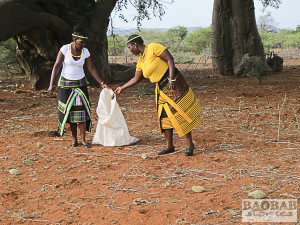Sylvia Mathoho lives in Zwigodini, a village in the area of Venda, Limpopo Province, South Africa. She collects Baobab fruit when they are ripe and sells them to Dr. Sarah Venter, Baobab ecologist and entrepreneur from Makhado (Louis Trichard). The sale of baobab fruit generates much appreciated income to her and her family.
She has participated in the Baobab Guardians Program since 2014 and has become a baobab “guardian” herself. The guardians program is part of the Eco Products Foundation founded by Venter. Among other objectives the program ensures that baobabs grow in the Venda area in future. The guardians plant baobabs and take care of them. In addition, people in the area receive training in baobab ecology and environmental protection.
Responsibility for a Tree
We visit Mathoho in her homestead. By the end of 2014 she has taken on responsibility for a small baobab seedling. She has to protect the tree from browsing goats and cattle and she has to water it regularly. The more water the mini baobab gets during his first years, the faster it grows and can take care of itself.
Surviving is particularly difficult for young baobabs. Hardly any of the small trees make it through their first three years without support. The population density in the regions with natural baobab occurrence has increased dramatically, and with it the presence of cattle and goats. These just love the tender young leaves of little baobabs and browse on them.
- Baobab with thorny fence
- Thorns for Baobab Protection
- Baobab with a Support Stick
Thorny Fences protect baobabs
To ensure the survival of the baobab near the fence of her homestead, the guardian has built a protective wall of thorns. This seems ideal for the tree – it gets enough light for its growth, can be properly watered and is well protected from hungry cattle. The “thorn method” for fencing is quite common in the area. Crops are protected with this natural fencing as well as cattle – they are kept in kraals overnight. The spikes are so sharp and long that no predator dares to break through this type of fencing.
Every Centimeter counts
Venter visits the baobab guardian’s village regularly. The baobabs are easily located because GPS data was taken and registered once they were planted. The height of the baobab is measured. It has grown a few centimeters since she last has been there. For every new centimeter the baobab keeper receives an expense allowance. Mathoho is happy that she could make some extra money with taking care of the tree.
Baobab Fruit have many uses
She reports that baobabs are still aplenty in the Venda area. They are called Mbuyu in the local language and have many uses. She lists a number of them for us:
- if a child suffers from diarrhea, a ripe fruit is taken, cracked open and water is poured inside. It is mixed with the fruit powder until the latter dissolves. The liquid is fed to the child. This helps to stop diarrhea and provides important nutrients to the child.
- for adults baobab powder is mixed with sugar and milk – which produces a thick, yogurt-like and slightly sweet-sour tasting drink that is very popular in the area
- the young, fresh leaves of baobab are prepared like spinach and eaten as a vegetable
- chewing on a piece of root from a baobab helps to relieve toothache
- when burned, the shells of the fruit produce a white powder, which is a natural raising agent
- the bark provides the material for very strong and durable ropes
- cattle are fed with leaves and flowers
The baobab Guardian goes on to say that baobabs are special and trees created by God. They have a positive image and are worthwhile protecting. One should not simply tear off branches or leaves or carve their bark. Baobabs must be respected, because they provide medicine and food.
Baobab fruit are very useful – particularly if one is traveling, no matter whether the distance is far or not. If one walks in the bush and gets hungry a fruit from the baobab tree can simply be picked up from the ground, cracked open and the powder from the inside can be eaten immediately. Everyone can do that. The fruit powder is very durable and does not have to be processed or prepared. One just needs to crack the hard shell.









